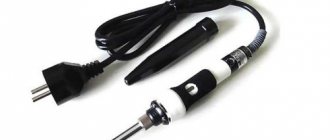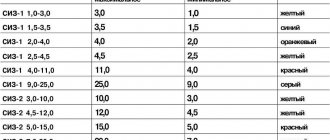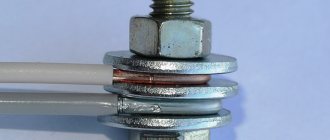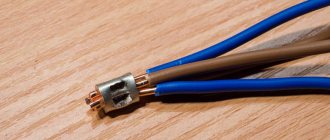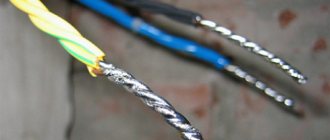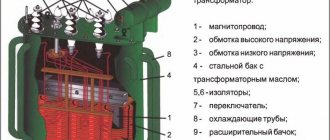Most of the mistakes made when installing electrical networks are related to incorrect connection of wires. The lack of current is explained by unreliable contacts or their failure in junction boxes, sockets, and devices. Before starting work, you need to carefully study all the cable installation methods and choose the most suitable one.
Types of conductors for connection
The most common type of cable (among those used in domestic conditions) is considered to be PVS. It consists of many copper wires covered with double braid. The conductors are twisted along the central axis. The product is flexible and can be used to form different branches of the electrical network. The cable is designed to operate under voltage from 220 to 380 V. When choosing a cross-section, take into account the current strength:
| Permissible load, A | Section, sq. mm |
| 6 | 0,75 |
| 10 | 1 |
| 16 | 1,5 |
In addition to PVS, stranded wires KG, PRS, PUGNP, ShVVP are found in connections. When installing a home electrical network, these types are used less frequently.
Wago
The next type is Wago terminal blocks. They also come in different sizes, and for different numbers of connected wires - two, three, five, eight.
They can connect both monocores and stranded wires together.
For stranded ones, the clamp must have a latch-flag, which, when open, easily allows you to insert the wire and clamp it inside after latching.
According to the manufacturer, these terminal blocks in home wiring can easily withstand loads of up to 24A (lights, sockets).
There are some compact specimens also available for 32A-41A.
Here are the most popular types of Wago clamps, their markings, characteristics and what cross-section they are designed for:
There is also an industrial series for cable cross-sections up to 95mm2. Their terminals are really large, but the principle of operation is almost the same as that of small ones.
When you measure the load on such terminals, with a current value of more than 200A, and at the same time you see that nothing is burning or heating, many doubts about Wago products disappear.
If you have original Vago clamps, and not a Chinese counterfeit, and the line is protected by a circuit breaker with a correctly selected setting, then this type of connection can rightfully be called the simplest, most modern and convenient to install.
Violate any of the above conditions and the result will be quite natural.
Therefore, there is no need to install wago at 24A and at the same time protect such wiring with a 25A automatic. In this case, the contact will burn out if overloaded.
Always choose the right terminal blocks for your car.
As a rule, you already have automatic machines, and they primarily protect the electrical wiring, and not the load and the end consumer.
ZVI
There is also a fairly old type of connection, such as terminal blocks. ZVI – insulated screw clamp.
In appearance, this is a very simple screw connection of wires to each other. Again, it comes in different sections and different shapes.
Here are their technical characteristics (current, cross-section, dimensions, screw torque):
However, ZVI has a number of significant disadvantages, due to which it cannot be called the most successful and reliable connection.
Basically, you can only connect two wires to each other in this way. Unless, of course, you specifically choose large pads and shove several wires there. What to do is not recommended.
This screw connection works well for monocores, but not for stranded flexible wires.
For flexible wires, you will have to press them with NShVI lugs and incur additional costs.
You can find videos online where, as an experiment, transition resistances on different types of connections are measured with a microohmmeter.
Surprisingly, the lowest value is obtained for screw terminals.
Methods for connecting conductors in a house or apartment
Correct cable splicing involves:
- reliable contact with a minimum resistance difference close to the parameter of a solid section of wiring;
- strength, resistance to vibration and tearing;
- homogeneity of metals (copper cannot be combined with aluminum).
Not all methods ensure that these requirements are met. The best are considered:
- soldering;
- twist;
- welding;
- crimp;
- use of terminal connectors.
Safety Tips and Rules
- Only craftsmen with a qualification group are allowed to weld. Welding is also permitted for people who have welding skills.
- Cables may only be connected in the manner permitted for them. Do not work with damaged cables. All exposed parts must be insulated.
- There are many ways to connect cables. The choice of connection method is determined by the material, cross-section diameter and other parameters. For electrical equipment to function properly, conductors must be securely connected. If contact is not secure, there is a risk of fire.
Removing the insulating layer from conductors
The copper portion of a stranded cable consists of many intertwined wires. Sometimes they are covered with a polymer layer and combined with nylon threads. This makes it difficult to remove the insulation. Depending on the connection method, the braid is removed by 0.2-5 cm. The insulation is carefully cut and removed, trying not to damage the core. When working with coaxial products, carefully remove the shielding layer, opening the barrel.
When working with thin enameled wires, use a soldering iron. The remaining coating is carefully removed with an abrasive material.
Purpose
Any connection method requires stripping the wire - exposing the metal core. The insulation is made of fluoroplastic, polystyrene, rubber. The inner layer may consist of varnish, silk or polyethylene. Removing the braid creates the contact needed to conduct electricity.
Required tools for stripping
To remove insulation use:
- loop burner or soldering iron;
- side cutters;
- construction knife;
- stripper.
Sleeves
When powerful clamps for several wires are needed, sleeves are used. They are a tinned copper tube or a flat tip with a hole made for fastening.
All connected wires must be inserted into the sleeve and crimped using a special crimper device (crimping pliers). This wire clamp has a number of positive aspects:
- It is very convenient to use lugs with holes when there is a need to secure wire assemblies to housings with screws.
- Crimping at the connection does not increase the resistance.
As you can see, there are a lot of wire clamps, each with its own advantages and disadvantages. Choose based on which wires you need to connect and where the connection will be located. But do not forget that the most important thing in electricity is reliability and safety.
Is it possible to connect conductors by twisting
Electrical Installation Rules (ELR) prohibit the use of this method separately. Twisting is combined with other methods. It is not used for combining cores made of different materials.
Methods
The following methods are used for twisting wires:
- Standard method. Before starting work, de-energize the network, remove the insulation by 5 cm. Unwind the conductors by 2 cm, connect them until the whole parts are joined. Next, twist it with your fingers and clamp it with pliers. Isolate the exposed area.
- Fastening cables of different sections. It is prohibited to use products with very different parameters. This makes contact unreliable. The cores of the twisted wires must be wound one on top of the other.
- Use of caps. Such elements well insulate the place where the conductors are combined. They are made of fire-resistant material. To perform twisting, the ends of the wires are stripped and connected. A cap is placed on the joint and turned until the exposed area is covered.
- Application of contact clamps. The element includes a base, a washer, a screw and a conductive core. The connection begins with stripping the wires. The ends free from insulation are inserted into the hole in the clamp. This method is used when working with single- or multi-core cables.
Brewing
After twisting, the wires are soldered. They are pre-tinned and treated with a heated soldering iron tip immersed in rosin. After this, the joint is coated with tin and heated until the melt begins to penetrate into the thickness of the cable. The method is time-consuming, but it helps to obtain the most reliable pairing.
Checking reliability
It should be noted that fixation on PPE is very similar to conventional twisting, but with one difference - the presence of an insulating cap on it. So if the torsional strength is not much different. For better conductivity, simply strip the connected wires.
Let's see how long a “forbidden” connection can resist breaking.
The test ended at more than 6 kg, as the thread was attached to the steelyard and the knot (not twisted) began to unravel.
Withstands more than 62 kN
Now all that remains is to securely insulate the seam with electrical tape or heat-shrink insulation. You can use this.
If you clean the contacts well and insulate them reliably, such a simple connection will last for years, for which there is a lot of evidence.
The reason for the twist ban is anyone's guess: it appears to be a commercial advantage for manufacturers of PPE, Vago connectors and screw terminals, two of which are prone to melting and causing fires.
Methods for connecting wires or cables to each other
To avoid emergency situations, the elements must be firmly fastened. It’s not just soldering that will help achieve this result. Using special tools allows you to quickly align the wires.
Crimping
The method involves the use of a special tool. Crimping with sleeves is performed when working with aluminum or copper. The connection is made like this:
- remove the braid by 2-3 cm;
- clean the core to a metallic shine;
- twist the conductors and insert them into the sleeve;
- crimp the connection with a special tool.
The main difficulty is the selection of the sleeve. Using an element with a smaller or larger diameter makes the bond weaker.
Bolted connection
To fasten the wires, washers, bolts and nuts are used. The design is reliable, but it takes up a lot of space. The cables are connected in this way as follows:
- remove insulation;
- the cleaned ends are folded into a loop, the diameter of which coincides with that of the bolt;
- put on the washer, put on the first conductor;
- install the second fastening element, put on the next cable;
- secure the structure with a nut.
Bolts are often used to hold together three or more wires. The nut is tightened with a wrench.
Terminal blocks
The element is made in the form of a metal plate enclosed in a dielectric housing. Connecting cables with terminal blocks does not cause any difficulties even for a novice master. The work is done like this:
- Clean the ends of the cables from the braid.
- Remove the oxide film with sandpaper.
- Insert the conductors into the sockets. Screw in the bolts.
The method is used when working with products of different sections. Terminal blocks can only connect two cables.
Self-clamping terminal blocks Wago
There are 2 types of such elements:
- Flat spring terminal blocks. They are disposable and cannot be reused after dismantling. The terminal block is equipped with a plate with flexible petals. When inserting the wires, they are pressed out, the cable is securely fixed by the device.
- With lever mechanism. It is considered the best type of fasteners. The stripped cable is inserted into the terminal, after which the lever is clamped. The device can be used several times.
Tips
You can connect the cable using 2 types of elements:
- when using the first type, the cables are connected in the cavity of the tip;
- in the second case, the wires are combined using different elements.
The first method helps to obtain a more durable joint. Manufacturers offer special tips for working with wires made of different materials.
Soldering tips
The element on the wire is clamped with a press. If it is not available, use the soldering method. The end of the cable and the clamp are tinned from the inside. The core is inserted into the tip. The structure is wrapped with fiberglass thread and heated until the solder melts.
Installation of PPE caps
To connect cables, PPE caps are used. To manufacture this product, polymer materials are used that do not support combustion when ignited and at the same time have electrical insulating properties. These devices can operate safely under a voltage of 600 V.
A steel spring is mounted in the body of the cap, compressing the conductor.
The housing, made of polymers, serves as protection for the connection; in addition, it insulates the junction of the wires. When cutting the insulation, the installer must ensure that the exposed metal does not extend beyond the cap, and at the same time falls into the action zone of the spring. When using PPE caps, there is no need to use additional insulating materials.
Conductor Connectors
This is the name for devices that facilitate the installation of electrical wiring consisting of several lines. They are either clamp or screw.
Couplings
The device looks like a hollow tube. It is used when working with cables with a cross-section of up to 16 square meters. mm. The wire is secured in the coupling by crimping. The device is not used when connecting single-core wires.
Clips
Before inserting the cable, the clamp of this device is installed vertically. Moving the element to a horizontal position helps secure the cores. Using a clip allows you to add additional wires.
Screw terminals
The elements are designed to combine conductors from different metals. The main advantage is ease of use.
Screw terminals
Used to work with cables made of copper and aluminum. They are not suitable for multi-core wires. Also, the clamp can contribute to the breakage of the aluminum core, so it is better not to combine it with this material.
Power clamps
The stripped wire is inserted into such a device until it stops. The pressure plate lowers, securing the cable. Power clamps are used when working with products made of different metals.
Spring terminals
Such elements make the connection strong and reliable. However, over time the spring may overheat.
Spring clamps
PPE caps are used as these elements. They help to quickly connect 2 conductors of the same diameter. It is important to choose the correct size of the device, otherwise there will be no contact.
Connection clamps
There are electrical and electrical types of devices. The difference lies in the permissible load. The wires are combined inside the clamps.
Terminal blocks
The terminal block is a contact plate in a polymer or carbolite housing. With their help, any user can connect the wires. Connection occurs in several stages:
- stripping of insulation 5-7 mm;
- removal of oxide film;
- installing conductors in sockets facing each other;
- bolting.
Pros: you can connect cables of different diameters. Disadvantages: you can only connect 2 wires.
Types of terminal blocks for multi-core and single-core cables
There are 5 main types of terminal blocks:
- knife and pin;
- life;
- locking and self-locking;
- hood;
- “walnut” type terminals.”
The first type is rarely used; they are not designed for high currents and have an open design. Screw terminals provide reliable contact but are not suitable for connecting multi-core cables.
Interlocking terminal blocks are the most convenient devices to use and do not require special equipment for installation. Caps are also used frequently, but unlike locking devices, caps can be used multiple times. "Nut" is practically not used.
Terminals in junction box (copper or metal)
Terminals are the most common connection method in a junction box. They are inexpensive, easy to install, provide a reliable contact seal and can be used to join copper and aluminum. Cracking:
- cheap, low quality household appliances;
- only 2 wires can be connected;
- not suitable for multi-core wires.
Selecting a connection method
There are a lot of methods for combining cables. The desired option is chosen taking into account the situation. For temporary mating, the bolting method or twisting is used, for permanent mating, soldering or crimping is used.
Stranded and single-core conductors
In this case, work begins with choosing the ratio of conductor sections. The multi-core element should not be thinner than a single element. In this case, the contact may be destroyed. The wires are fastened by welding, soldering or crimping. When using a soldering iron, the ends of the cables are cleared of braid. The multi-core element is wound onto a single element.
The soldering area is carefully insulated. When crimping, a sleeve is put on the ends of the wires, which is clamped with pliers.
Wires with cross-sections of different diameters
The connection in this case requires calculation of the current density. If the parameter is acceptable, the elements are fastened with bolts, clamps, soldering or twisting. The process is no different from that when working with the same conductors.
Large conductors
The connection is difficult to make due to the large contact area. Fixing thick wires is only possible by welding. It cannot be done at home, since the conductors must be heated to a high temperature. After welding is completed, check the functionality of the wiring. When splicing thick cables, you can use a coupling.
Broken wires in the wall
Wiring in the pipe may be damaged during repair work. Troubleshooting begins after the power supply is turned off. The broken wires are connected like this:
- Using special tools, they look for the break point. Remove the layer of plaster, gaining access to the desired area.
- Remove insulation from the ends of the damaged cable. Treat bare areas with molten solder.
- Select a second cable of the appropriate cross-section. It is cut off and soldered to both ends of the damaged wire. The length being extended should not be too short or long.
- Insulate the soldering area. To do this, use a heat-shrink tube, which is put on the repaired area. When heated with a hair dryer, the material tightly envelops the joint.
Welding – high reliability in any conditions
When connecting wires by soldering, the wires are twisted and their ends are soldered.
The result is a metal ball that provides a stable and very reliable connection in any conditions. In addition, it is reliable not only from the point of view of electrical characteristics, but also mechanically: the metal of the connected wires after melting forms a monolith, and it is impossible to insulate a separate wire.
Soldering: It is important to heat the metal but not melt the insulation
The disadvantage of this type of cable connection is that the connection is 100% solid. If you need to change something, you will have to cut off the casting and do it all over again. Therefore, for such connections there remains a certain supply of cables in case of possible modifications.
Other disadvantages include the welding machine, associated electrodes, consumption and performance. In addition, welding takes a long time, it is necessary to protect surrounding objects, and it is also inconvenient to work with a welder at height.
Therefore, electricians practice this type of connection in exceptional cases. If you do it yourself and are good with a welder, you can practice on scraps. The main trick is not to melt the insulation, but to weld the metal.
After cooling, the welding site is isolated. You can use electrical tape, you can use heat shrink tubing.
How to connect headphone wires
It is recommended to repair broken cables by soldering. To do this, perform the following steps:
- Cut off the damaged piece. Remove the braid by 2-3 cm. The number of cores depends on the type of headphones. The simple device has 4 wires insulated with multi-colored rubber. A twisted pair cable consisting of grounding and signal cables is connected to the microphone. The first one is covered with yellow insulation.
- After stripping all the conductors, twist the copper hairs. Burn the contacts with a lighter, removing the varnish coating. It not only prevents soldering, but also impairs current conduction.
- Treat bare areas with tin. Heat shrink tubing is placed over the wire braid. The same material is used to insulate each core.
- Tinned sections are twisted taking into account the color of the insulation. The connections are heated with a soldering iron until the tin is evenly distributed.
- Check that the work is being done correctly. When sound appears in the speakers, a bandage is applied to the repaired area. To do this, put heat-shrinkable tubes on the twists and heat them with fire. Insulation prevents short circuits.
- Tie the wiring harness together with a thread and slide the thick heat-shrinkable tube that was put on earlier.
Scotchlock
For telecommunication systems, it is most convenient to use adhesive tape. This device is made of plastic and has metal contacts inside. The adhesive tape connector provides a high level of insulation. Without a soldering iron, without twisting, the wires are clamped by the device. The connection is provided with good insulation and protection from moisture. The main thing with this method is not to forget to take into account the cross-sectional diameter of the wire.
Additional recommendations
When fastening cables, you should follow these tips:
- Welding or soldering ensures a permanent connection. You don't have to worry about the reliability of the contact. This option is well suited for large cross-section conductors.
- Terminals help speed up wiring work. This method can be used when connecting sockets or lights.
- PPE clamps make the connection not only strong, but also safe. The items are not expensive.
- Do not immediately place the fastened elements into the junction box. It is necessary to check whether they get hot during operation.
The correct choice of connection method and compliance with safety precautions prevent injury to people or damage to property.
GOST classifications and requirements
Cable connectors are all devices used to open/close an electrical circuit.
These can be electrical installation products - sockets, switches, as well as metal busbars and plates, cable lugs, terminals and terminal blocks - blocks with several sockets.
We will focus on connectors in the strict sense of the word - on elements that create folding and non-folding connections and guarantee their reliability and functionality, that is, on all types of terminals, terminal blocks and sleeves.
The simplest example of a ferrule for a stranded wire. The terminal is a metal sleeve attached to the end of the core using crimping pliers
Terminals are called both metal elements for decorating the ends of single-core and twisted wires, and small plates inside connecting devices: sockets, terminal blocks, patch panels.
The classification of electrical connectors is presented in GOST 10434-82, which provides information on the division into classes (1, 2, 3) and groups (A, B). In addition, according to the standards, contact connections are divided into removable and permanent, which require stabilization or work without it.
The terminals differ in material, shape and size, but are similar in purpose - they provide mechanically strong switching of two or more wires without electrical losses and installation difficulties
Some tips may be useful not only to professionals, but also to home craftsmen who independently arrange electrical wiring.
For example, he talks about the most preferred methods of joining aluminum plates - welding or soldering, and aluminum tips - crimping or soldering.
